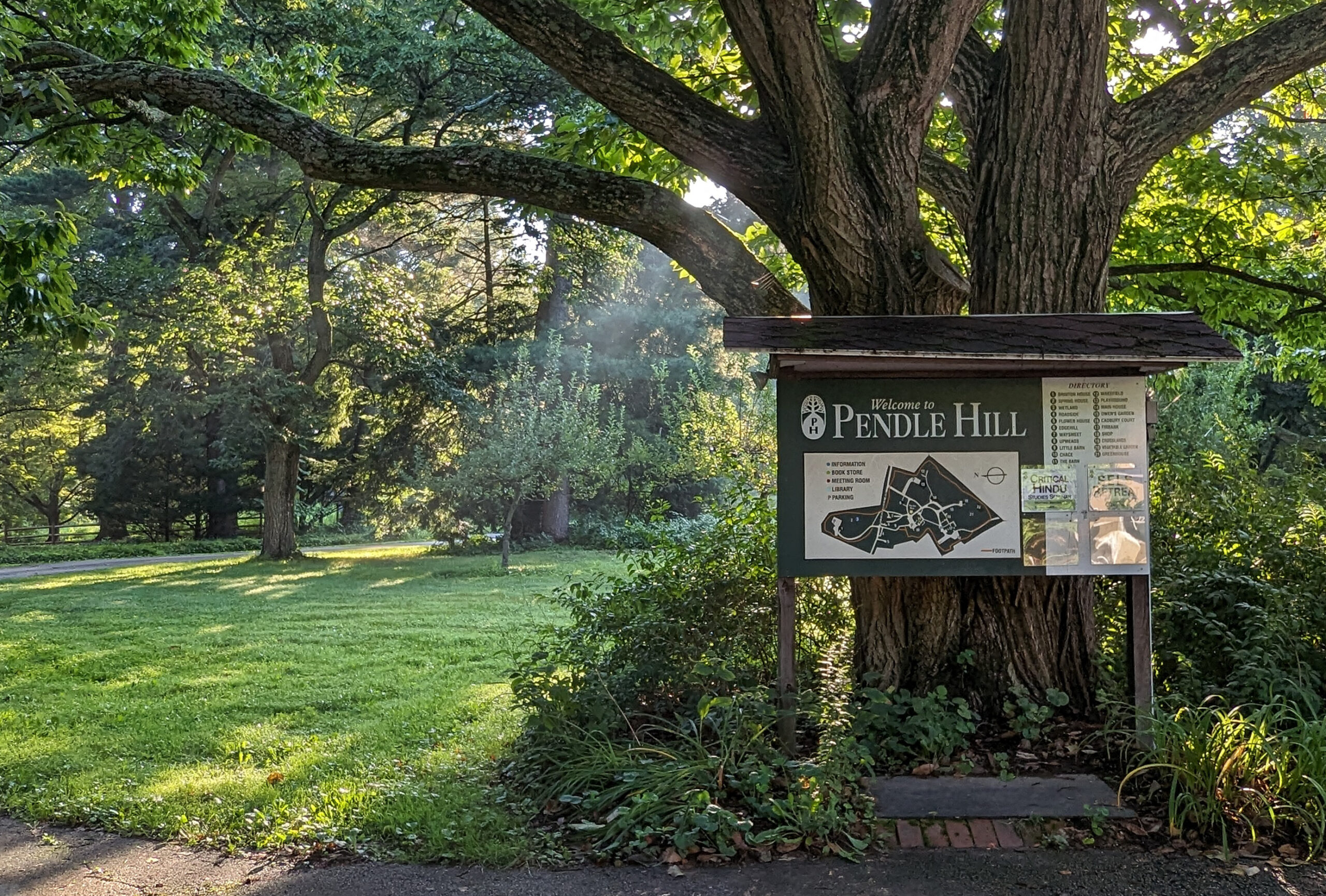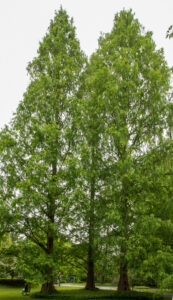Grounds & Arboretum
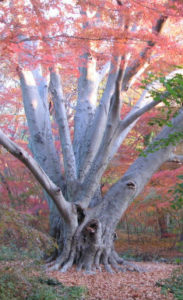 Pendle Hill is part of a rich Quaker tradition that has had a significant influence on Pennsylvania horticulture. In the Philadelphia area alone there are many Quaker-affiliated private and public Gardens and Arboretums. Concern and respect for God’s creation has guided this deep interest in care for the grounds. At Pendle Hill, our management of the property attempts to achieve this respect for the earth by using sound cultural practices and a minimum of chemical controls. Various types of ecosystems are encouraged to invite a diversity of flora and fauna to an otherwise suburban geography.
Pendle Hill is part of a rich Quaker tradition that has had a significant influence on Pennsylvania horticulture. In the Philadelphia area alone there are many Quaker-affiliated private and public Gardens and Arboretums. Concern and respect for God’s creation has guided this deep interest in care for the grounds. At Pendle Hill, our management of the property attempts to achieve this respect for the earth by using sound cultural practices and a minimum of chemical controls. Various types of ecosystems are encouraged to invite a diversity of flora and fauna to an otherwise suburban geography.
The original 8 acres purchased in 1930 has grown over time to some 24 acres. A mile-long perimeter path contains our 13 buildings and various ecosystems of forest and lawn, meadow and wetland, vegetable garden and native wildflower meadow. Many species of birds and small animals have been sighted on land at Pendle Hill, and bullfrogs, snapping turtles, and carp have all been seen in our wetland pond near Brinton House.
This description of the property will take you to sites along the trail where you can personally meet some of our greatest spiritual guides – the plants and animals of Pendle Hill. So let’s take to the path and heed the words of early Friend, George Fox, to “walk cheerfully over the earth, answering that of God in everyone.”
Experience the Campus
The grounds, including the 1-mile walking trail, are open to the public every day from dawn until dusk. Trail signs and maps are located along the way.
Pendle Hill’s campus is also a designated zone in iNaturalist. Take a look at all the flora and fauna other guests have found during their visit, and add your own observations!
Fossils from the Jurassic era can prove the existence of this species in pre-historic North America. Dawn Redwoods were thought to be extinct by western scientists until they were rediscovered growing in Asia. They were reintroduced to North America in the 1930s. The three trees growing by the mound were planted by staff members Wilf Howarth and Lloyd Lewis to memorialize board member Roy McCorkel following his death in 1966.
Sugar Maples
The tradition of tapping these native trees for their sap was started by Native Americans who first observed the sweet water leaking from a tomahawk-pierced tree. At Pendle Hill, the now obsolete tradition of tapping the Sugar Maples for syrup is revealed on certain trees by the circular scars in the trunk at about waist height. Practitioners of this winter time tradition of “reaping the season’s first harvest” include naturalist Ewell Gibbons, author of Stalking the Wild Asparagus. Ewell worked at Pendle Hill in the late 1950s.
 Canadian Hemlock
Canadian Hemlock
This is the Pennsylvania state tree. Recently the health of this species has been threatened by woolly aphid infestations. This particular tree is over 100 feet tall and from its top one can view boats traveling on the Delaware River. Its height is 17 feet shy of the state champion Hemlock.
Penn Treaty Elm
In 1682 William Penn signed a Peace Treaty with the Delaware Indians under the noble canopy of an American Elm. Before that historic tree blew down in 1810, a shoot was transplanted to the home of a General Paul Oliver in Bay Ridge, New York and then moved again to his home in Wilkes Barre, Pennsylvania. Haverford College was presented with a scion from that tree and others were propagated. The Pendle Hill specimen was a seedling from the Haverford collection and was planted here in the 1970s. It was removed in 2020 after loosing the battle to Dutch Elm disease, but a seedling was preserved for future growth.
American Beech
It is estimated that this native is over 300 years old. It is listed in E.E. Wildman’s book, Penn’s Woods 1682-1932, which documents many of the trees that are thought to have been alive when a wide-eyed William Penn first stomped through the Pennsylvania forest. Our very own “Mama Beech” has become a cultural landmark on campus.
 Bamboo
Bamboo
Actually a member of the grass family, bamboo makes a sturdy building material for fences and trellises around Pendle Hill. Like many other ornamental introduced plants, this species of bamboo is an invasive in Pennsylvania. The bamboo at Pendle Hill was part of the Brinton House property as purchased in 1970, and the grounds crew continues to work to control its growth.
Meadows
The establishment of meadows at Pendle Hill was done as a way to introduce a more diverse collection of native flora and fauna. An annual early-spring mowing of the space interrupts the natural progression of a bare field to a hardwood forest by keeping young trees and shrubs in check and allowing wildflowers and grasses to flower and go to seed. This creates the necessary food and shelter for wildlife to inhabit that a mowed lawn prohibits.
 Wetlands
Wetlands
This pond, which had all but disappeared due to silt, was restored as a wetland in 2002 with the help of a government program called Partners for Wildlife. It attracts a variety of waterfowl such as herons, mallards, wood ducks, and kingfishers. Bullfrogs, snapping turtles, and grass carp are a few of the other inhabitants that can be sighted from the shore.
Kentucky Coffee Tree
This tree is proof that the desperate nature of the addicted coffee drinker transcends time! The common name of the tree is given to us by the early white settlers to Kentucky who used the seed from this tree as a coffee substitute. As Donald Peattie writes in A Natural History of Trees of Eastern and Central North America, “The appearance of the beans or seeds, rather than the taste, must have induced the pioneers to roast and brew them to make what can only by imagination and forbearance be called coffee.”
 Ginkgo
Ginkgo
This tree species has been growing on the earth for 150 million years and was native to North America at one time, though it became extinct and was later reintroduced. The female is famous for its stinky fruits which don’t show up until the tree is 20 to 50 years old. The Ginkgo is renowned for its medicinal qualities that aid in memory loss, headaches, and depression.
The Labyrinth
The earliest known labyrinths date back 3000 years. They have been built with stone and painted on cave walls. They are found in many cultures in all parts of the world. In the Christian tradition they are used as a meditative tool. Unique to the Pendle Hill labyrinth is the planting of potatoes for the walls.
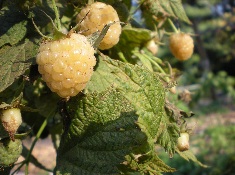 Organic Garden
Organic Garden
The vegetable garden has been supplementing our meals with fruits and vegetables since the day Pendle Hill first opened its doors in 1930. Today, this “biointensive kitchen garden” continues to supplement our meals and is a demonstration site for biointensive methods of food production. The cob and straw bale constructed greenhouse is, in the words of designer/builder K.C. Kurtz, “built of locally harvested, recycled, and non-toxic materials employing sustainable, low-tech building principles.” A hoop house allows Pendle Hill to produce greens year round.
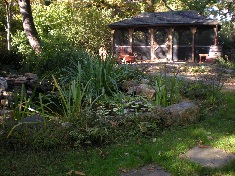 Owen’s Garden
Owen’s Garden
A friend of Pendle Hill made the construction of this garden possible through a designated gift. The waterfall and fishpond were critical in the overall design as both a focal point and a reminder of the essential nature of water for all life forms. Critters with wings, scales, and tails can be seen bathing and drinking from its rocky stream every day of the year.
Travel Directions to Pendle Hill.


